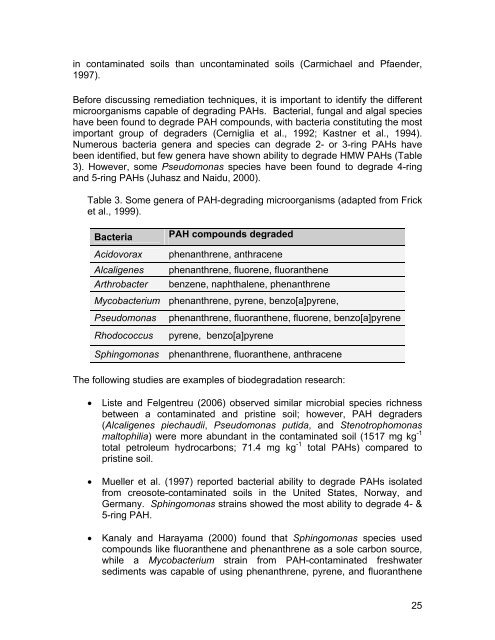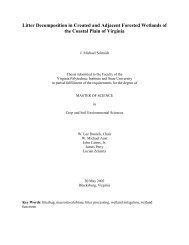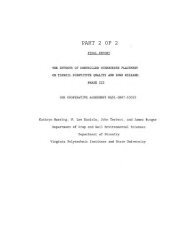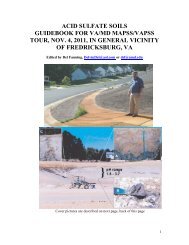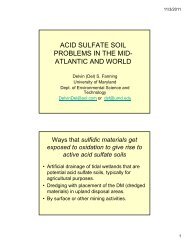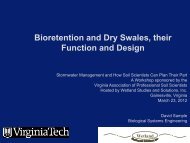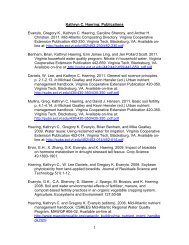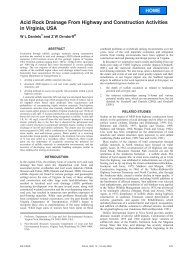Remediation of PAH-Contaminated Soils and Sediments: A ...
Remediation of PAH-Contaminated Soils and Sediments: A ...
Remediation of PAH-Contaminated Soils and Sediments: A ...
Create successful ePaper yourself
Turn your PDF publications into a flip-book with our unique Google optimized e-Paper software.
in contaminated soils than uncontaminated soils (Carmichael <strong>and</strong> Pfaender,<br />
1997).<br />
Before discussing remediation techniques, it is important to identify the different<br />
microorganisms capable <strong>of</strong> degrading <strong>PAH</strong>s. Bacterial, fungal <strong>and</strong> algal species<br />
have been found to degrade <strong>PAH</strong> compounds, with bacteria constituting the most<br />
important group <strong>of</strong> degraders (Cerniglia et al., 1992; Kastner et al., 1994).<br />
Numerous bacteria genera <strong>and</strong> species can degrade 2- or 3-ring <strong>PAH</strong>s have<br />
been identified, but few genera have shown ability to degrade HMW <strong>PAH</strong>s (Table<br />
3). However, some Pseudomonas species have been found to degrade 4-ring<br />
<strong>and</strong> 5-ring <strong>PAH</strong>s (Juhasz <strong>and</strong> Naidu, 2000).<br />
Table 3. Some genera <strong>of</strong> <strong>PAH</strong>-degrading microorganisms (adapted from Frick<br />
et al., 1999).<br />
Bacteria<br />
<strong>PAH</strong> compounds degraded<br />
Acidovorax phenanthrene, anthracene<br />
Alcaligenes phenanthrene, fluorene, fluoranthene<br />
Arthrobacter benzene, naphthalene, phenanthrene<br />
Mycobacterium phenanthrene, pyrene, benzo[a]pyrene,<br />
Pseudomonas phenanthrene, fluoranthene, fluorene, benzo[a]pyrene<br />
Rhodococcus pyrene, benzo[a]pyrene<br />
Sphingomonas phenanthrene, fluoranthene, anthracene<br />
The following studies are examples <strong>of</strong> biodegradation research:<br />
� Liste <strong>and</strong> Felgentreu (2006) observed similar microbial species richness<br />
between a contaminated <strong>and</strong> pristine soil; however, <strong>PAH</strong> degraders<br />
(Alcaligenes piechaudii, Pseudomonas putida, <strong>and</strong> Stenotrophomonas<br />
maltophilia) were more abundant in the contaminated soil (1517 mg kg -1<br />
total petroleum hydrocarbons; 71.4 mg kg -1 total <strong>PAH</strong>s) compared to<br />
pristine soil.<br />
� Mueller et al. (1997) reported bacterial ability to degrade <strong>PAH</strong>s isolated<br />
from creosote-contaminated soils in the United States, Norway, <strong>and</strong><br />
Germany. Sphingomonas strains showed the most ability to degrade 4- &<br />
5-ring <strong>PAH</strong>.<br />
� Kanaly <strong>and</strong> Harayama (2000) found that Sphingomonas species used<br />
compounds like fluoranthene <strong>and</strong> phenanthrene as a sole carbon source,<br />
while a Mycobacterium strain from <strong>PAH</strong>-contaminated freshwater<br />
sediments was capable <strong>of</strong> using phenanthrene, pyrene, <strong>and</strong> fluoranthene<br />
25


